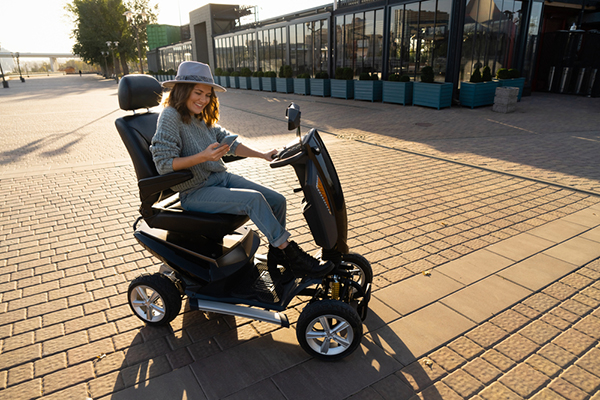Buying Guide
For sales & advice, please call our store or send us an email
Types of Scooters
Mobility scooters are an ideal way of retaining your independence by providing you with the ability of getting out and about without any assistance. They can provide you with the freedom of being able to go to the shops, visit family and friends or just to take a trip out.
When purchasing a mobility scooter, you will need to take various things into account. We hope the following information will help you make the right choice.
There are 3 types of mobility scooter:

Car Boot Scooters
These are lightweight, easily manoeuvrable and suitable for short trips. They can be easily dismantled to put into a car boot. They have a top speed of 4mph.

Pavement Scooters
If you are going to be spending more time on your mobility scooter, travelling greater distances and also navigating kerbs and hills you may need to look at a larger, sturdier model. These are still for pavement use only and they also often have a higher weight limit and more features.

Road Scooters
These are 6 or 8mph scooters that can be used on both the pavement and the road. They have lights and indicators and are more comfortable for longer distances. You do not need a driving licence or need to take a test to use a class 3 scooter and they are not subject to road tax or mandatory insurance. However we do register class 3 mobility scooters with the DVLA for our customers so that they receive an owners log book. We also advise to take out insurance which can be obtained when purchasing your scooter.
It is not permitted to use mobility scooters on motorways, cycle or bus lanes and is not advisable to use them on unrestricted dual carriageways ( ie with a speed limit of 50mph or more )
If you do use a 4 wheeled mobility scooter on a dual carriageway then you must have a visible amber flashing light.
The highway code must be adhered to at all times when using your mobility scooter on the road
The following construction features must apply
- a maximum unladen weight of 150 kg (330 lbs);
- a maximum width of 0.85 metres (2’9″);
- a maximum speed of 12.8 km/h (8 mph);
- an efficient braking system;
- front and rear lights and reflectors, indicators and hazard warning lights
- an audible horn
- a rear view mirror
Key questions to consider
Mobility scooters are simple to use, economical to run and easy to maintain. When choosing the right scooter for you, there are some things to take into account:
Car trips – Will I want to take it in the car?
If the answer is yes, then you would need to look at lighter car boot scooters. These are the portable type that can be easily disassembled into approx 5 pieces and fit into your car. They may be less comfortable than the larger scooters as they have small, solid tyres, smaller seats and rarely any suspension.
Location – Where will I use my scooter?
Consider the areas you will be going on your scooter, will there be a lot of drop kerbs and if so are they drop kerbs. If the answer is yes then a scooter with good ground clearance and a larger battery capacity would be a good option.
Usage – How often will I use it and how far will I go?
If you are going to use a scooter for longer journeys then you need to think about the comfort aspect, ie legroom, suspension, adjustable seat. Also speed will be an important factor as you won’t want to do a 20 mile trip at 4mph therefore you might want to look at 6 or 8mph class 3 scooters
Storage space – Where are you going to keep it?
You need to think about where you will be storing the scooter when you are not using it. Larger scooters are generally quite wide, so you need to be close to a power socket so as to charge the scooter when required. The ideal place would be in your garage. If you cannot store it in a garage, then maybe it would fit in your home. If this is the case then make sure it will go through your doors and consider whether you will need an access ramp. The other option is outside but if this is the case then you will need to make sure it is covered over to keep it clean and dry.

Maintenance & Care
Mobility scooters require little maintenance.
You should keep the scooter clean and store in a dry place away from rain.
Check the tyre pressures regularly (refer to the user manual).
Your scooter batteries need to be kept fully charged to maintain them and prolong their life.
We strongly advise that you regularly charge your scooter to help keep the batteries in the best condition possible. Should you leave the batteries without charging them they could be damaged beyond repair. Just like a car your scooter will need to be serviced on an annual basis, failure to do so could invalidate your warranty.




